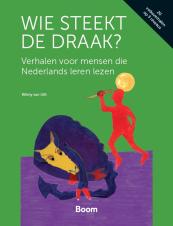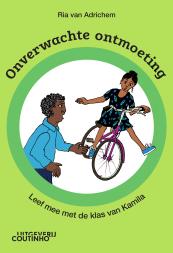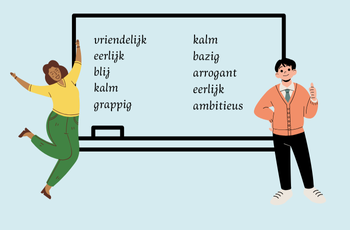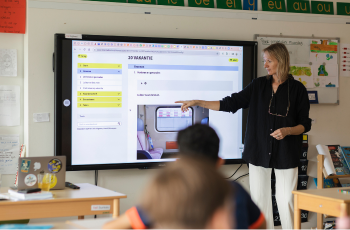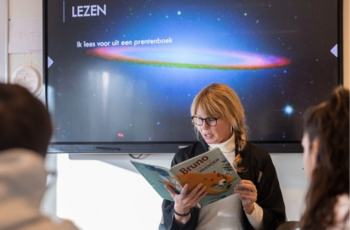More reading in class
Reading in NT2 class starts with pleasure
Reading is for everyone. Although the learning needs are not the same for every student, every student benefits from improving their reading skills. Especially now that the language requirement for status holders has been raised to language level B1, a good command of reading skills is indispensable.
To get students to the right level, reading lessons must therefore become even more efficient and effective. But for really good reading skills, it is important to start working on the pleasure of reading, because reading well starts with having the desire to read.
From technical reading to reading comprehension
Anyone who wants to increase the reading pleasure of students must first think differently about reading and not just see reading as a skill. Indeed, real reading is more than just the technical skill of reading, as in linking letters together to form words and sentences.
In the NT2 Cahier Doing More with Reading, the authors describe reading as follows: 'Reading is reading a text fluently, correctly, expressively and with understanding. The result of these reading acts is reading comprehension. So reading comprehension is not the reading process itself, but is the outcome of a good reading process. (Karin van de Mortel, 2015).
Reading is a means and not the end. But note, with this we are not saying that technical reading does not require attention. On the contrary, it is very important to keep training technical reading skills to an advanced stage, because those who read slowly and spend too much mental capacity on technical reading have too little room left for reading comprehension. When you do not understand what you are reading well and reading feels like work, it comes at the expense of reading pleasure.
Small effort, big effect
Reading pleasure and motivation go hand in hand. One cause of reduced reading pleasure may be that learners feel that their efforts are ineffective. After all, learning to read well takes time.
It is therefore important to motivate your students to keep reading. No matter how long or short. Because even if you read one minute a day, you read a total of 106,000 words on an annual basis. The table below clearly illustrates the impact of daily reading.
Tip: use the table during conversations with your students to emphasize the importance of reading.
Cultural differences can influence reading pleasure
Many students are not used to reading for fun. Reading for pleasure is not equally common in every culture. So students need to learn why it is enjoyable and what are the benefits of reading for pleasure.
That is why it is important that as a teacher you introduce reading in a positive way, make the reading material easy and attractive as well as support the students. In this way you give your students everything they need to discover why reading is enjoyable. And the best by-product is: the more they read, the more they “boost” their language acquisition. (Bamford & Day, 2014, in NT2-Cahier Doing More with Reading)
Two pillars increase reading pleasure in the NT2 classroom
There are two main pillars for increasing reading pleasure: your approach and the material. In a classroom situation, as a teacher you are often tied to a curriculum. Texts in the curriculum are often dialogues or short informative texts that serve the lesson material. They are often not authentic or focused on reading pleasure. And that while those two things are of great importance.
Moreover, the often stripped-down texts are often counterproductive. They are so stripped down and condensed that they are more difficult to read because they are no longer focused on reading pleasure, no imagination is possible and, for example, because signal and conjunction words have been omitted so that the reader has to make all the connections between the sentences and parts of sentences himself.
When the material is limited to the texts from the teaching method, a student cannot make his or her own choices either. After all, the text has to be read in order to do the assignments in the book or on the computer.
In addition, they are all about learning a language. And because students do not often come into contact with texts that are fun to read outside of class, the higher goal is not achieved: getting students to actually read by stimulating the pleasure of reading.
So it is up to you as a teacher to find out what your students enjoy reading. Introduce them to different genres (fiction and non-fiction) and especially use texts with as rich and varied language as possible.
This way, students can discover what they like to read and what possibilities there are. The NT2 Cahier Meer doen met lezen also contains various tips for discovering with students what they like to read. A tip of the hat:
- Read silently on a regular basis, for example 10 minutes at the beginning of the lesson.
- Read aloud and have students read along.
- Let trainees choose what they want to read.
- Don't always use difficult texts but rather texts whose words are familiar.
- Take your students to the library, see where you can find stray books, or go to the book section in a thrift store.
- A tip outside the Cahier: start working with picture books in NT2 class.
Getting mileage out of reading in NT2 class
To learn to read well, it is important to make kilometers, but preferably fun kilometers of course.
For beginning readers the books Water to Milk, Bears on the Road and Who Sticks the Dragon are very suitable. Students can work with them on their own, but there are also various forms of classroom work. Both books are written and narrated at three levels and are therefore widely applicable to the alpha group.
For fun reading milestones at the next level, the books published by Eenvoudig Communiceren are indispensable in NT2 lessons. Eenvoudig Communiceren has a large selection of books, from novels to literary thrillers, at different levels, from A1 (extra easy) to B1 (easy). We list our favorites:
- Lichter dan ik: a story about love set over 150 years ago in the Dutch East Indies, during the time of the Dutch occupation.
- We slaves of Suriname: the story of Anton de Kom, a man who loves his country, and cares about his fellow man. From this love, he tells the story of slavery in Suriname.
- Everybody gets hit: about 17-year-old Taha who is determined to stay on the right track after he gets out of a juvenile institution. He decides to take up boxing and has serious talent, but then something happens that jeopardizes everything....
Rich texts in NT2 class
Above all, look beyond the boundaries of existing material and explore different reading sources. Try to keep in mind that you want your students, regardless of their language level, to enjoy reading.
The books Rich Language (for primary and secondaryschools ) are a great success and help everyone in education to look at reading material and the reading approach with different eyes. The book teaches teachers to create rich contexts, with rich texts and teaches teachers to shape active thinking about language and interesting topics. In the book you will find dozens of practical tools to give students and trainees the right support and (co-)teach a good language base.
Good example
In addition to materials, it is important to take a good look at your approach. Use fun methods, for example. In the NT2-Cahier Meer doen met lezen you will find per subtopic several ways of working and you will get plenty of inspiration to work with reading in your lessons and to stimulate your students to pick up a book outside of class.
But above all, remember: a good example follows well. Show that you enjoy reading yourself, take books with you to school, show picture books and read aloud regularly. Enjoy reading!

